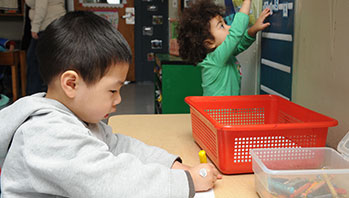- crayons
- markers
- paper
- pencils
- caption
- dirt
- grow
- plant
- seed
- sprinkle
MA Standards:
Writing/W.PK.MA.2: Use a combination of dictating and drawing to explain information about a topic.
Head Start Outcomes:
Literacy Knowledge/Early Writing: Experiments with writing tools and materials.
Literacy Knowledge/Early Writing: Uses scribbles, shapes, pictures, and letters to represent objects, stories, experiences, or ideas.
PreK Learning Guidelines:
English Language Arts/Composition 16: Use their own words or illustrations to describe their experiences, tell imaginative stories, or communicate information about a topic of interest.
Make a Book About Seeds

© Commonwealth of Massachusetts, Department of Early Education and Care (Jennifer Waddell photographer). All rights reserved.
Skill Focus: Concepts of Print (word spaces), Dictating Sentences, Fine Motor Skills, Writing, Letter Recognition
Educator Prep: Fold two sheets of paper in half to make a four-page book for each child. Make the cover out of folded construction paper. Title each book I Planted a Seed. Include an “author” line.
Tell children they are going to record what they learned about planting seeds in a book called I Planted a Seed.
- Hold up a cover and have children look for and name the letters they recognize. Then read the title—I Planted a Seed. Tell children they are going to make a book about planting seeds. Say, What do you think you can put on the cover of your book that will show readers the book will be about planting seeds? After several children respond, distribute the books and tell children to write their names on the author line and to draw a picture on the front that will help people know what the book is about.
- Next ask children to describe the steps in planting seeds. Explain that on each page of their book, they can draw a picture to show the sequence of how their plants grow. For example, one page might show the seed going into the dirt; another page could show the plant sticking up out of the soil; the next might show the child sprinkling water on the plants.
- The pages can be wordless or you can write captions as children dictate words and sentences to describe what they observed.
- Talk with children about their observations and, when the books are completed, display them in the Library Center for everyone to share.
